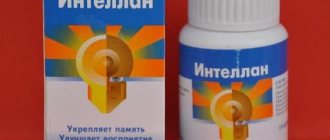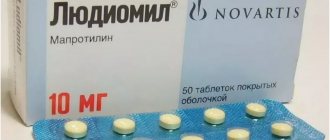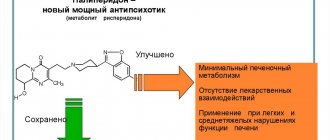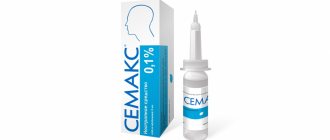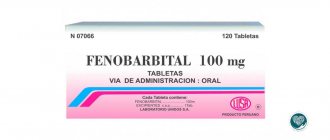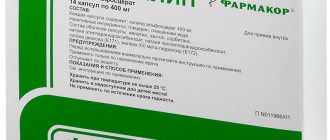pharmachologic effect
The tablets contain a medicinal substance that is a derivative of 1,4-benzodiazepine and has sedative , anticonvulsant and anxiolytic effects.
The action of the active substance is associated with the receptor complex. It includes gamma-aminobutyric acid, GAM-A receptor, benzodiazepine receptor and chloride channel. The active substance inhibits several structures in the central nervous system, in particular the spinal column, limbic system, cerebral cortex, hypothalamus and cerebellum. This substance has a strong anxiolytic effect, hypnotic and sedative activity, reduces the severity of seizures and the tone of skeletal muscles.
Relium in ampoules has hypnotic, anticonvulsant, sedative and anxiolytic effects. The action of the active substance is to influence GABA-A receptors and gamma-aminobutyric acid, which is an endogenous neurotransmitter involved in inhibition processes in the central nervous system. When using the solution, patients experience a decrease in seizures and slight relaxation of skeletal muscles. It also has some hypnotic effects.
General information about the drug Relium
Relium is a standard psycholeptic of European quality. It is produced in Warsaw (Poland) at the Polfa pharmaceutical concern. The medication has a combined effect, providing anticonvulsant and sedative effects. The drug is on the list recommended for availability in medical institutions compiled by the World Health Organization.
Drug group, INN, scope of application
Relium belongs to the pharmacological group of psycholeptic drugs, a subgroup of anxiolytics, benzodiazepine derivatives. A special feature of this group is that all drugs included in its composition are sold strictly according to prescription. International nonproprietary name (INN) is Diazepam.
The drug is actively used in psychiatric, neurological and drug addiction practices. It can also be used in selected clinical cases of infectious diseases.
Release forms
Available in the form of film-coated tablets. Each tablet is round, biconvex, yellow in color. Dosage is exclusively 5 mg.
The price of medicine in Russian pharmacies differs slightly.
| A drug | Pharmacy name, city | Price in rubles |
| Relium 5 mg, No. 20 | APTEKA LLC, St. Petersburg | 40 |
| Pharmaceutical Leasing LLC, St. Petersburg | 39 | |
| WER.RU, Moscow | 31.9 | |
| Farmalizing LLC, St. Petersburg | 27.5 | |
| Apteka.ru, Smolensk | 31 | |
| Low price pharmacy, Moscow | 33 | |
| Apteka.ru, Orel | 3410 | |
| Laboratory of beauty and health, Moscow | 38 | |
| Online pharmacy GORZDRAV, Moscow and region | 30 |
Pharmacodynamics and pharmacokinetics
Bioavailability after oral administration is 98 percent. The maximum level of the active substance in the serum is observed after 0.9-1.3 hours and is 500 ng/ml. The main part of the active substance in the serum is in bound form. The half-life lasts up to two days. Diazepam penetrates the blood-brain and blood-placental barriers, and is also detected in small amounts in breast milk. Metabolization occurs in the liver and is excreted through the urinary system.
When administered by injection, high concentrations of the active substance are observed in amniotic and synovial fluids, as well as in breast milk. This substance tends to accumulate in adipose tissue and is subsequently released into the bloodstream. Approximately 25 percent is excreted unchanged.
Reviews about the application
Reviews of people who directly take Relium and use it in daily clinical practice are presented below.
Doctors
Experts generally speak positively about the drug:
- Evgenia Marenkova, psychiatrist: “Relium is based on a component that is the main one, according to the approved local protocols for providing care to patients. I prescribe it because it combines many positive qualities. First, efficiency. Secondly, ease of use. Thirdly, affordability. I see excellent dynamics in patients during treatment with this drug and am ready to recommend it for regular use.”
- Alexander Sviridov, narcologist: “The drug is new to me and little studied in the practice of a narcological hospital. I’m used to using Diazepam, and, if necessary, Sibazon. I don’t see any point in switching to prescribing another medication, since these are effective and show excellent clinical data.”
Patients
Patient reviews are quite varied:
- Angelica Demina: “I suffer from frequent anxiety states. I periodically undergo treatment in the department of a psychiatric hospital. During my last hospitalization, my doctor advised me to start treatment not with my usual medication, but with Relium. He convinced me of the effectiveness of therapy. To be honest, I didn’t believe it because I didn’t know anything about this medicine. After reading the information on the Internet, I was pleasantly surprised by the large number of positive reviews. I tested the positive qualities of Relium on myself. I advise everyone".
- Vasily Vyatkin: “I am satisfied with the Relium treatment regimen prescribed by my doctor. I have suffered from epilepsy since birth. I tried many medications. I won’t say that Relium is the best of all, but it’s not the worst either. The effect was and remained for quite a long time. I didn’t like the presence of side symptoms. I got them literally after two days of taking them. We adjusted the daily dose, and everything went away. I have a neutral attitude towards this drug.”
Today, most specialists consider Relium as the drug of first choice in the treatment of both psychotic disorders and convulsive syndromes of various origins. However, its use in real clinical practice is limited by the relatively low level of information doctors have about it and their adherence to more classical drugs. It is important that its use is cost-effective, since it allows not only to reduce the frequency of relapses and readmissions of patients to a psychiatric hospital, but also, in some cases, to improve the social functioning of such people. Also, in addition to everything, the drug is effective for all forms of psychosis and other psychiatric disorders.
Indications for use of Relium
Indications for use are as follows:
- neuroses , anxiety , restlessness , borderline states with manifestations of tension;
- tetanus , premature placental abruption, premature birth , facilitation of labor;
- premedication before anesthesia;
- status epilepticus;
- arthritis , bursitis , myositis , which are accompanied by tension in the skeletal muscles, spastic conditions that are associated with damage to the spinal cord and brain;
- withdrawal syndrome in chronic alcoholism, motor excitation of various etiologies in psychiatry and neurology, sleep disorders;
- cardioversion.
Analogues of the drug
It is worth noting that Relium has a sufficient number of generics (medicines similar to it in chemical structure and therapeutic effect). Let's look at the most commonly used ones:
- Diazepam is available in two dosages: 5 and 10 mg per tablet. All pharmacodynamic and pharmacokinetic properties are similar to those of Relium. The medicine is its complete analogue. Produced in Ukraine by ODO. Its price is a little cheaper.
- Diazepex is one of the few anxiolytics available in liquid form. 1 ml of solution for injection contains 10 mg of diazepam. It also contains 96% ethyl alcohol. It is administered intramuscularly. It can also be taken orally in selected cases. Manufacturer – JSC “Kalceks”, Latvia.
- Sibazon - also available in the form of a solution for injections. 1 ml contains 5 mg of the active ingredient (diazepam). Indications for use are similar to those of the drug in question. Pharmacodynamics are no different. It is used intravenously slowly or by drip, in rare cases - intramuscularly. It is an emergency drug for status epilepticus. Also, unlike all other drugs in this group, it is used when an attack of eclampsia occurs during pregnancy or childbirth.
Side effects
When using Relium, drowsiness, muscle weakness and fatigue are often observed, which spontaneously disappear after a couple of days. Other unwanted effects may also occur:
- allergic reactions: anaphylactic reactions, rash , itching and urticaria ;
- drug addiction;
- ECG changes, hyperhidrosis , convulsions , pain in joints, bones and muscles, increased risk of fractures, respiratory failure , liver dysfunction, increased activity of liver enzymes, jaundice , urinary incontinence or retention;
- bowel disturbances, nausea , colic , dry mouth or hypersalivation , vomiting , anorexia ;
- decreased visual acuity, vertigo , diplopia ;
- changes in blood composition, neutropenia ;
- confusion , emotional poverty, depression , decreased attention, deviant behavior , nightmares , psychosis , hostility, irritability , anxiety , hallucinations , agitation ;
- anterograde amnesia (with high doses of diazepam), anger, aggression , disorientation , dizziness , speech , tremor , headache , mood lability, loss of consciousness , dysarthria ;
- heart failure (up to cardiac arrest), arterial hypotension , bradycardia , circulatory failure, chest pain.
Instructions for use of Relium (Method and dosage)
According to the instructions for use of Relium, tablets are taken regardless of food, the dose is selected individually for each patient.
As a rule, in most cases for anxiety conditions, 1 tablet per day is prescribed. The maximum dose is 30 milligrams per day. For spastic conditions, 5 to 15 milligrams per day are prescribed. The maximum dose is 60 milligrams per day. For insomnia associated with anxiety, 5 to 15 milligrams are prescribed. It is recommended to take the medicine 20-30 minutes before bedtime. For premedication , 5 to 20 milligrams of diazepam .
During therapy, it is recommended to use only the minimum doses of the active substance that provide a therapeutic effect (the dose can be increased only in cases where there is a significant need to enhance the effect). It is not advisable to use the full dose more than four times a week.
The maximum duration of treatment is one month, for anxiety conditions - from 8 to 12 weeks (the time for drug withdrawal is included in the periods).
The solution is administered intravenously or intramuscularly. Injections can be done no more often than every 3-4 hours, in extremely severe cases they can be done every hour. The drug must be injected into a vein very slowly, otherwise collapse . Patients over 65 years of age, as well as weakened patients, can be prescribed only minimal doses.
The solution can be administered intravenously only into large veins; intraarterial administration is unacceptable. It can be administered intramuscularly only into large muscles. This medicine can only be administered separately, as it is incompatible with other medicines.
Indications and detailed instructions
The list of indications for the use of Relium is constantly expanding, thanks to comprehensive research conducted by both pharmacists and clinicians. Today, the list of conditions for which it is used is as follows:
- acute and chronic anxiety disorders, including those associated with the presence of concomitant diseases (oncology of any localization, hypertension);
- tetanus or diseases manifested by increased tone of skeletal muscles (arthritis, myositis, post-stroke condition) - in combination with the main therapy;
- spastic syndromes associated with a disorder of the functioning of the upper motor neuron in the medulla oblongata (paraplegia, athetosis);
- withdrawal syndrome due to alcohol or drug addiction;
- insomnia associated with feelings of fear;
- epilepsy - as an additional component of the main treatment;
- convulsive syndrome.
Restrictions
It is prohibited to use it if at least one of the following conditions is present:
- hypersensitivity to the components of the drug;
- severe respiratory failure of both peripheral and central origin;
- myasthenia gravis;
- angle-closure glaucoma;
- severe liver or kidney failure.
Separately, it is worth noting that Relium cannot be used in obstetric practice, since it has a detrimental effect on uteroplacental blood flow and, therefore, disrupts the intrauterine development of the fetus. Use of the medication after 34 weeks of pregnancy causes disturbances in the fetal heart rate and distress syndrome. Children born to mothers taking Relium lose their sucking reflex and develop respiratory problems.
Prescribing psycholytic drugs during lactation is also excluded. In this situation, it is necessary to decide: either the woman is breastfeeding the child or taking the drug. At the same time, these things are incompatible.
In pediatric practice it is used in isolated cases and very rarely. This is due to the fact that children need a smaller dosage, but there is no such alternative. And dividing one tablet into several parts does not always lead to the desired effect. Therefore, in this situation, the choice remains with the attending physician.
Dosage
The duration of treatment and dosage are determined solely by the doctor in each individual case. The treatment regimens indicated by the manufacturer are indicative and recommended. In practice, sometimes you have to adjust them. Let's look at the main ones:
- Anxiety – 5-10 mg twice a day, regardless of meals.
- Alcohol withdrawal syndrome - start with 10 mg three times a day, then 5 mg 4 times.
- Hypertonicity – 2 tablets 3 times a day.
- Trouble falling asleep - 2 tablets immediately before bedtime.
- Premedication – 5-20 mg.
The duration of medication treatment depends on the diagnosis and can be 4-12 weeks. When treating elderly patients, it is necessary to take into account that you should start with a minimum dose and gradually increase it. It cannot be canceled abruptly. The dose reduction occurs in the opposite order.
Overdose
In case of overdose, dysarthria , nystagmus , drowsiness and ataxia . apnea , coma , depression of cardiac and vascular function, and arterial hypotension can also sometimes be observed . In people with diseases of the respiratory system, with an overdose, respiratory depression becomes more pronounced.
Treatment consists of eliminating symptoms, supportive therapy (carrying out artificial respiration (in the absence of consciousness), monitoring the functions of the cardiovascular, nervous and respiratory systems). To reduce the absorption of diazepam, enterosorbents are prescribed (gastric lavage is not recommended).
Interaction
Concomitant use with drugs that depress the central nervous system (including opioid analgesics , hypnotics , sedatives , antipsychotics and anesthetics respiratory center, and also contributes to the development of severe arterial hypotension .
Simultaneous use with ethanol or drugs containing ethanol enhances the inhibitory effect on the central nervous system (especially the respiratory center) and contributes to the development of pathological intoxication syndrome.
Concomitant use with disulfiram , omeprazole , cimetidine increases the intensity and duration of exposure to diazepam.
Concomitant use with fluvoxamine increases plasma concentrations and side effects of diazepam.
Phenytoin and phenobarbital accelerate the metabolism of diazepam, and rifampicin increases its elimination. Paracetamol reduces the excretion of diazepam, and simultaneous use with risperidone promotes the development of NMS.
Simultaneous use with metoprolol leads to a deterioration of psychomotor reactions and a decrease in visual acuity, with lithium carbonate - leads to the development of a coma, with levodopa - suppresses the antiparkinsonian effect, with clozapine - causes loss of consciousness, respiratory depression and severe arterial hypotension, with diclofenac - causes increased dizziness, with bupivacaine - increases its concentration in the blood plasma, with oral contraceptives - enhances the effect of diazepam and can lead to breakthrough bleeding , with muscle relaxants - enhances their effect and increases the risk of apnea , with tricyclic antidepressants (including amitriptyline ) - enhances a depressant effect on the central nervous system, enhances the cholinergic effect and increases the concentration of antidepressants.
Simultaneous use with caffeine reduces the sedative and anxiolytic effects of the drug. Medicines that cause induction of liver enzymes, including anti- epileptic ( phenytoin , carbamazepine ), accelerate the elimination of diazepam.
In people who have been taking cardiac glycosides , anticoagulants , beta-blockers , and antihypertensive drugs , the mechanisms and extent of drug interactions may be unpredictable.
Relium
General information regarding observed effects following treatment with benzodiazepines and other drugs of similar action, which should be taken into account when prescribing diazepam.
Tolerance. Regular use of benzodiazepines (including diazepam) may lead to a weakening of their effect.
Drug addiction. The use of benzodiazepines can lead to the development of mental and physical drug dependence. The risk of developing drug dependence increases with the dose and duration of treatment, and increases in patients with alcohol dependence, as well as in patients with a history of drug dependence.
"Oricochete syndrome syndrome." After treatment ends, there may be a transient relapse of symptoms that are more severe than those that caused the initial treatment (so-called “rebound” insomnia). These symptoms are often accompanied by mood changes, anxiety, restlessness, sleep disturbances and insomnia.
The patient should be informed about the possibility of rebound insomnia. This information will reduce his concern if such symptoms appear after stopping the drug.
The likelihood of developing withdrawal syndrome or rebound insomnia increases with abrupt cessation of drug use. To reduce the risk of developing these symptoms, a gradual dose reduction is recommended.
Anterograde amnesia. Diazepam, as well as other benzodiazepines and similar drugs, can cause anterograde amnesia. This condition most often occurs several hours after taking the drug, especially in a large dose. Symptoms of amnesia may be accompanied by behavior that is inappropriate to the situation. To reduce the risk of anterograde amnesia, it is recommended to take the drug half an hour before bedtime and ensure conditions for continuous sleep for 7-8 hours.
Mental and paradoxical reactions. The use of diazepam can cause abnormal (opposite to expected) mental and paradoxical reactions, such as: anxiety, agitation, irritability, aggressiveness, anger, nightmares, hallucinations, psychosis, somnambulism, personality disorders and other behavioral disorders. These reactions are much more common in elderly patients and in patients with alcohol dependence.
If such symptoms occur, you should immediately stop taking the drug. Specific patient groups
Elderly patients are recommended to prescribe smaller doses, due to a possible increase in side effects, mainly disorders of orientation and coordination of movements (falls, injuries).
The use of benzodiazepines in patients with severe hepatic impairment is not recommended as they may precipitate the development of hepatic encephalopathy.
The drug should be used with caution in patients with chronic respiratory failure, since it has been established that benzodiazepines can have a depressant effect on the respiratory center.
Initiation of treatment with diazepam or its abrupt withdrawal in patients with epilepsy or epileptic seizures may accelerate the development of seizures or status epilepticus.
The use of benzodiazepines and similar drugs in patients with psychosis is not recommended.
Diazepam should be used with great caution in patients with symptoms of depression. These patients may develop suicidal tendencies. Due to the possibility of intentional overdose, these patients should be prescribed benzodiazepines in the smallest doses possible.
Benzodiazepines should not be used as monotherapy for depression or anxiety associated with depression. Monotherapy with these drugs may increase suicidal tendencies.
In cases of bereavement or mourning, benzodiazepines may slow psychological awareness and acceptance of the situation.
Benzodiazepines and similar drugs should be used with great caution in patients with a history of alcohol, drug or drug addiction. Such patients must be strictly monitored during treatment, because are at risk of developing addiction and mental dependence.
Diazepam should be used with caution in patients with porphyria. The use of diazepam may increase the symptoms of this disease.
Diazepam should be used with caution in patients with glaucoma (may be used in patients with open-angle glaucoma who receive appropriate treatment, but is contraindicated in closed-angle glaucoma).
During long-term therapy, periodic blood tests (morphology with smear) and liver function tests are indicated.
Due to the lactose content, Relium should not be used in patients with rare hereditary galactose intolerance, lactase deficiency or poor absorption of glucose-galactose.
The drug Relium may cause allergic reactions due to the content of the azo dye quinoline yellow.
During treatment with diazepam and for 3 days after its completion, you should not drink any alcoholic beverages.
Analogs
Level 4 ATC code matches:
Bromazepam
Helex
Rudotel
Nozepam
Tazepam
Xanax
Elenium
Valium Roche
Alprazolam
Tofisopam
Diazepam
Grandaxin
Mezapam
Sibazon
Seduxen
Relanium
Lorazepam
Analogues are:
- Apaurin;
- Seduxen;
- Diazepam;
- Relanium;
- Valium.
